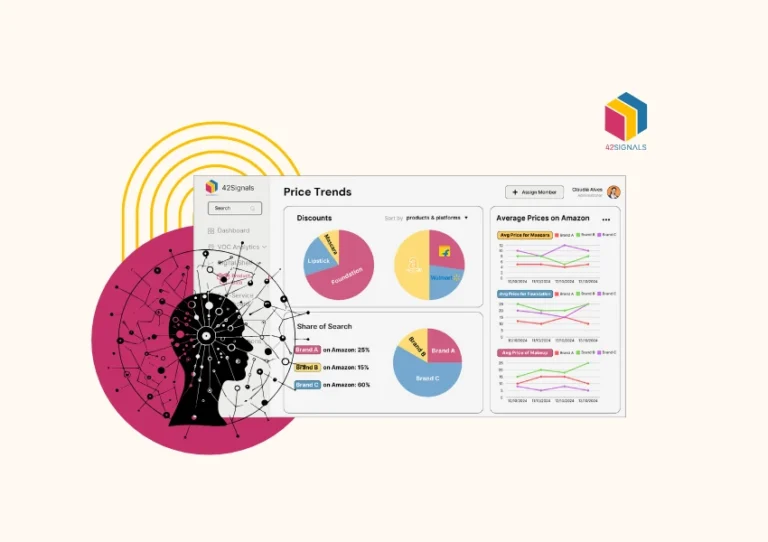Competitor price tracking can be considered a reliable yardstick of measurement that brands employ to gauge the effectiveness or ineffectiveness of competitor strategies compared to their own. It’s the process of monitoring and analyzing product pricing data and using that knowledge to your brand’s advantage.
In 2022, the online retail market size reached 73 billion USD, and global retail e-commerce sales are forecasted to reach 8.1 trillion USD by 2026. The rise of e-commerce sales and digital-first brands has made competitor price tracking easier than ever compared to the alternative of the pre-internet era where such a task – day-to-day price monitoring – would be unimaginable.
With several tools readily available in the market, real-time data about your competitor’s performance is just a click away. 42Signals for instance, can accurately track and map product listings across marketplaces. The platform is also able to analyze competitors’ inventory to ensure that your products never run out of stock. This makes brand monitoring a crucial part of the business strategy.
Let’s take a deeper dive into how these valuable market insights can shape your business strategies and help you identify new opportunities for growth.
Why is Competitor Price Tracking Important?
Competitor price tracking is essential for businesses to stay competitive and adapt to market dynamics. It helps optimize pricing strategies, improve customer retention, and respond quickly to market changes.

By monitoring competitors’ pricing, businesses gain valuable insights for strategic decision-making, identify opportunities for growth, and maintain a balance between profitability and customer satisfaction. This practice ensures businesses remain relevant and agile in an ever-changing marketplace.
1. Gives your products a fighting chance
In today’s marketplace, there are numerous options and products available to consumers, leading to an abundance of choices. With even slight price variations being a deciding factor, consumers can quickly switch to another brand in search of a better deal. Competitor price monitoring is crucial for brands to stay ahead of the competition and maintain market share. By monitoring competitor prices, brands can make informed decisions and adjust their pricing strategy, ultimately attracting more customers and increasing revenue.
2. Helps you identify new opportunities
With consistent monitoring of competitor data, businesses can identify trends and capitalize on them to improve their market position. This can spark new ideas for marketing products with unique selling points or developing a better pricing model to differentiate themselves from competitors. By leveraging these opportunities, businesses can expand their customer base and increase revenue over time.
3. Equips you to make informed business decisions
Tying in with the first two points, competitor price tracking can steer business decisions in the right direction. By having access to the pricing strategies of your competitors, brands can use this data to evaluate where they want to position themselves in the market segment. For instance, brands can opt to cater to the higher end of the market by positioning their product as a ‘premium’ or ‘elite’ service. Alternatively, they can choose to stay within the same price range as their competitors and use effective messaging to differentiate their product and make it a more appealing choice.

Source: Single Grain
How to Use Competitor Price Tracking to Your Advantage
Price is a crucial factor that influences consumer purchase decisions, and determining optimal pricing requires considering concepts like price elasticity. Real-time product analysis of your competitors through brand monitoring can help you refine pricing strategies and make informed business decisions. To begin, you must –
• Identify Competitors
Identifying your competitors is an essential step in market research and one that should not be overlooked. It’s important to identify similar brands and products offering services similar to yours, which provides a clear area of focus. This helps your business understand the competitive landscape and benchmark your brand’s performance against other brands. It’s worth noting that competitor analysis is not a one-time activity. The competitive landscape is constantly changing, and new competitors can enter the market at any time. It’s important to regularly monitor your competitors via competitor price tracking to ensure you’re aware of any changes to their products, pricing, or marketing strategies.
• Select Products to be Tracked
It may not be feasible for small brands with a large inventory of products to have all products tracked simultaneously. Focusing on the best-selling items or products bound to perform well from your market research analysis can make it easier to pick and choose the ones to track.
• Identify an E-Commerce Analytics Platform
With many tools available, it is essential to select the right e-commerce analytics platform that provides a comprehensive solution for monitoring competitor pricing strategies. 42Signals is one such platform that provides insights into digital shelf analytics, the voice of customer analytics, and social media listening, giving a holistic picture of your brand’s online presence and performance.
• Analyze Data & Make Strategic Decisions
Use the data obtained from the analytics platform to guide pricing strategies. The analysis of competitor data can help identify trends or gaps in the market that your brand can fill. For example, if competitors lower prices on the weekends resulting in higher consumer traffic, your brand can use the same strategy to avoid losing customers.

Source: Mayple
Conclusion on Competitor Price Tracking
Competitor price tracking is an essential tool for businesses to compete in today’s marketplace. Though there are several brands vying for customers’ attention, there’s enough room for every business to not just survive but thrive. Effective price tracking allows businesses to identify new market opportunities and build a strong customer base by offering competitive pricing.
Price tracking can also benefit in improving the overall customer experience as consumers appreciate a good deal and are more likely to remain loyal to a brand that consistently offers competitive prices. It builds loyalty and trust.
Needless to say, all these strategies employed correctly help increase revenue and your brand’s market share. A well-executed pricing strategy can be the difference between a brand that experiences minimal growth and one that sees a tenfold increase in sales and market share.
Give 42Signals a try if you’re interested in looking at an ecommerce analytics tool for your business.





